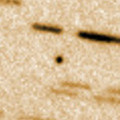
|
Now it is 11.6 mag (Oct. 13, Chris Wyatt). It will pass the perihelion on Oct. 27. In the Southern Hemisphere, it will be unobservable soon. In the Northern Hemisphere, it is not observable at all in this apparition.
Date(TT) R.A. (2000) Decl. Delta r Elong. m1 Best Time(A, h)
Oct. 14 13 36.68 -39 7.0 0.932 0.526 31 9.2 18:50 ( 61,-29)
Oct. 21 13 30.91 -28 32.8 0.885 0.316 18 6.4 4:46 (289,-25)
|
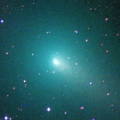
|
Now it is bright as 8.3 mag (Oct. 14, Juan Jose Gonzalez). It stays 8 mag within October. In the Northern Hemisphere, it stays observable in excellent condition for a long time. In the Southern Hemisphere, it will be unobservable soon.
Date(TT) R.A. (2000) Decl. Delta r Elong. m1 Best Time(A, h)
Oct. 14 4 40.58 49 57.7 0.722 1.499 120 8.4 3:11 (180, 75)
Oct. 21 4 47.69 57 54.4 0.722 1.501 121 8.5 2:51 (180, 67)
|

|
It brightened up to 7.1 mag from May to June (June 21, Juan Jose Gonzalez). Now it is fading. It has already faded down to 12.3 mag (Oct. 12, Chris Wyatt). In the Southern Hemisphere, it stays observable for a long time after this. It will never be observable again in the Northern Hemisphere.
Date(TT) R.A. (2000) Decl. Delta r Elong. m1 Best Time(A, h)
Oct. 14 16 59.05 -54 31.1 2.549 2.295 64 11.3 18:50 ( 27,-10)
Oct. 21 17 20.11 -55 24.4 2.660 2.355 61 11.5 18:42 ( 26,-10)
|
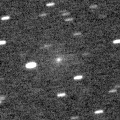
|
Now it is bright as 10.9 mag (Oct. 3, Juan Jose Gonzalez). It stays 10 mag until December. It is observable in good condition in the Northern Hemisphere. It locates very low for a long time in the Southern Hemisphere.
Date(TT) R.A. (2000) Decl. Delta r Elong. m1 Best Time(A, h)
Oct. 14 9 56.85 17 4.9 1.558 1.285 55 11.9 4:41 (275, 37)
Oct. 21 10 25.63 15 25.4 1.522 1.257 55 11.4 4:46 (277, 37)
|
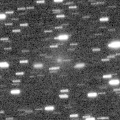
|
Now it is 12.9 mag (Oct. 1, Artyom Novichonok). It stays 11 mag until winter. It is observable in good condition in the Northern Hemisphere. It locates low in the Southern Hemisphere.
Date(TT) R.A. (2000) Decl. Delta r Elong. m1 Best Time(A, h)
Oct. 14 9 11.06 17 10.1 1.521 1.433 65 11.9 4:41 (282, 46)
Oct. 21 9 35.59 16 7.9 1.475 1.415 66 11.6 4:46 (285, 47)
|
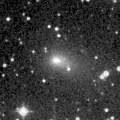
|
Now it is 13.2 mag (Oct. 3, Juan Jose Gonzalez). It will stay bright as 11 mag for a long time from winter to next spring. In the Southern Hemisphere, it stays observable in good condition until next February. In the Northern Hemispehre, it stays observable for a long time after this until the comet fades out.
Date(TT) R.A. (2000) Decl. Delta r Elong. m1 Best Time(A, h)
Oct. 14 5 36.62 -1 6.4 2.842 3.378 114 12.6 4:07 ( 0, 54)
Oct. 21 5 35.35 -0 33.2 2.711 3.334 121 12.4 3:38 ( 0, 54)
|
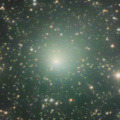
|
It brightened up to 10 mag from spring to summer. Now it is fading. It has already faded down to 13.0 mag (Oct. 12, Chris Wyatt). It is observable in excellent condition in the Southern Hemisphere. It locates low in the Northern Hemisphere.
Date(TT) R.A. (2000) Decl. Delta r Elong. m1 Best Time(A, h)
Oct. 14 19 45.91 -32 47.6 1.546 1.867 91 13.0 18:50 ( 8, 22)
Oct. 21 20 2.48 -31 38.7 1.641 1.900 88 13.2 18:42 ( 9, 23)
|

|
Now it is very bright as 12.2 mag (Oct. 12, Chris Wyatt).
Date(TT) R.A. (2000) Decl. Delta r Elong. m1 Best Time(A, h)
Oct. 14 21 4.10 -14 44.7 5.344 5.814 113 13.4 19:32 ( 0, 40)
Oct. 21 21 4.44 -14 40.2 5.449 5.813 106 13.4 19:05 ( 0, 40)
|
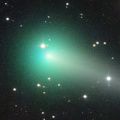
|
It brightened up to 6.2 mag in April (Apr. 7, Juan Jose Gonzalez). Now it is fading rapidly. It has already faded down to 13.8 mag (Sept. 30, Ken Harikae). It stays observable for a long time after this.
Date(TT) R.A. (2000) Decl. Delta r Elong. m1 Best Time(A, h)
Oct. 14 3 41.06 21 29.2 1.695 2.560 142 13.8 2:12 ( 0, 77)
Oct. 21 3 33.66 20 51.0 1.724 2.641 151 14.0 1:37 ( 0, 76)
|
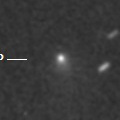
|
It brightened very rapidly from July to August. Now it is very bright as 14.1 mag (Sept. 27, Chris Wyatt). It is observable in excellent condition in the Southern Hemisphere. It stays low for a while in the Northern Hemisphere.
Date(TT) R.A. (2000) Decl. Delta r Elong. m1 Best Time(A, h)
Oct. 14 0 6.20 -36 8.4 1.889 2.670 132 14.2 22:33 ( 0, 19)
Oct. 21 0 0.94 -35 31.5 1.909 2.641 128 14.1 22:00 ( 0, 20)
|
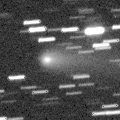
|
It brightened up to 12.2 mag in August (Aug. 21, Juan Jose Gonzalez). It is fading now. It has already faded down to 14.0 mag (Oct. 1, Michael Jager).
Date(TT) R.A. (2000) Decl. Delta r Elong. m1 Best Time(A, h)
Oct. 14 7 52.50 10 22.0 1.454 1.654 82 14.1 4:41 (311, 56)
Oct. 21 8 1.79 10 8.1 1.438 1.708 87 14.3 4:46 (320, 59)
|
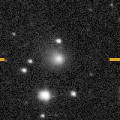
|
Now it is 14.5 mag (Sept. 22, Sandor Szabo). It is expected to brighten up to 10 mag in summer in 2018. In the Northern Hemisphere, it stays observable until 2018 summer while the comet will be brightening. In the Southern Hemisphere, it is hardly observable in 2017, but it will be observable in good condition in 2018.
Date(TT) R.A. (2000) Decl. Delta r Elong. m1 Best Time(A, h)
Oct. 14 17 12.33 25 15.2 4.222 3.930 66 14.7 18:50 ( 90, 48)
Oct. 21 17 16.23 23 16.7 4.234 3.873 62 14.6 18:42 ( 89, 44)
|
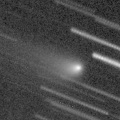
|
Now it is 14.4 mag (Sept. 19, Toshiyuki Takahashi). It will be fading after this.
Date(TT) R.A. (2000) Decl. Delta r Elong. m1 Best Time(A, h)
Oct. 14 19 19.51 -12 51.0 2.593 2.763 89 14.7 18:50 ( 20, 40)
Oct. 21 19 13.60 -13 59.8 2.760 2.777 80 14.8 18:42 ( 27, 37)
|
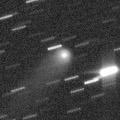
|
Now it is 14.2 mag (Sept. 22, Sandor Szabo). It will be observable at 14 mag for a long time from 2017 to 2018. In the Southern Hemisphere, it will be hardly observable after this. It will be extremely low from November to December in the Northern Hemisphere.
Date(TT) R.A. (2000) Decl. Delta r Elong. m1 Best Time(A, h)
Oct. 14 16 7.11 19 15.7 4.462 3.899 50 14.7 18:50 ( 92, 32)
Oct. 21 16 8.21 19 3.4 4.497 3.881 46 14.7 18:42 ( 94, 28)
|
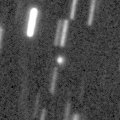
|
Now it is 13.7 mag (Sept. 22, Sandor Szabo). It is expected to brighten up to 12 mag from 2018 to 2019. In the Northern Hemisphere, it stays observable in good condition while the comet will be brightening gradually. In the Southern Hemisphere, it is not observable until 2018 October.
Date(TT) R.A. (2000) Decl. Delta r Elong. m1 Best Time(A, h)
Oct. 14 14 58.72 48 15.6 4.263 3.873 60 14.9 18:50 (130, 31)
Oct. 21 15 1.61 47 45.4 4.208 3.825 60 14.8 18:42 (130, 28)
|
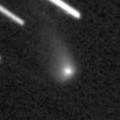
|
Now it is 14.7 mag (Oct. 1, Catalina Sky Survey). It stays observable at 15-16 mag for a long time from 2017 to 2018.
Date(TT) R.A. (2000) Decl. Delta r Elong. m1 Best Time(A, h)
Oct. 14 1 25.26 18 33.9 3.317 4.301 169 14.9 23:51 ( 0, 73)
Oct. 21 1 14.39 16 31.4 3.308 4.294 170 14.9 23:13 ( 0, 71)
|
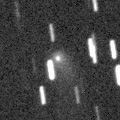
|
Now it is 14.6 mag (Sept. 25, Seiichi Yoshida). In the Northern Hemisphere, it stays 15 mag until winter, and it is observable in excellent condition. It is not observable at all after this in the Southern Hemisphere.
Date(TT) R.A. (2000) Decl. Delta r Elong. m1 Best Time(A, h)
Oct. 14 20 36.80 69 26.7 2.811 3.210 104 15.1 19:03 (180, 56)
Oct. 21 20 18.35 68 21.0 2.840 3.216 103 15.2 18:42 (176, 56)
|
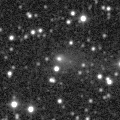
|
Now it is 14.9 mag (Sept. 26, Alexander Baransky). It brightened rapidly. It is observable at 15 mag in autumn in good condition in the Northern Hemisphere. It locates low in the Southern Hemisphere.
Date(TT) R.A. (2000) Decl. Delta r Elong. m1 Best Time(A, h)
Oct. 14 5 31.53 31 49.8 1.284 1.944 116 15.3 4:02 ( 0, 87)
Oct. 21 5 37.01 33 4.4 1.240 1.958 121 15.2 3:40 ( 0, 88)
|

|
Now it is 15.3 mag (Sept. 17, Artyom Novichonok). It stays observable at 16 mag unil the end of 2017.
Date(TT) R.A. (2000) Decl. Delta r Elong. m1 Best Time(A, h)
Oct. 14 3 36.11 0 48.5 5.221 6.060 144 15.4 2:07 ( 0, 56)
Oct. 21 3 34.21 0 23.8 5.203 6.089 150 15.4 1:37 ( 0, 55)
|

|
Now it is 15.9 mag (Aug. 26, Hiroshi Abe). It will be unobservable in late October in the Northerm Hemisphere, or in late November in the Southern Hemisphere.
Date(TT) R.A. (2000) Decl. Delta r Elong. m1 Best Time(A, h)
Oct. 14 17 5.12 -27 12.7 3.325 2.910 57 15.5 18:50 ( 43, 12)
Oct. 21 17 16.23 -27 30.2 3.401 2.910 52 15.6 18:42 ( 45, 11)
|
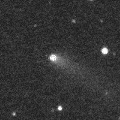
|
Now it is 15.4 mag (Sept. 28, Yasukazu Ikari). It will be fading after this, and it will be fainter than 18 mag in March.
Date(TT) R.A. (2000) Decl. Delta r Elong. m1 Best Time(A, h)
Oct. 14 1 18.95 17 59.4 1.921 2.909 170 15.7 23:46 ( 0, 73)
Oct. 21 1 13.28 17 55.3 1.933 2.919 169 15.7 23:12 ( 0, 73)
|
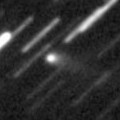
|
Now it is 15.7 mag (Sept. 13, Martin Masek). It stays 15 mag until winter. In the Southern Hemisphere, it stays observable in excellent condition until spring in 2018. In the Northern Hemisphere, it stays unobservable until 2018.
Date(TT) R.A. (2000) Decl. Delta r Elong. m1 Best Time(A, h)
Oct. 14 2 38.95 -80 22.0 1.975 2.228 90 15.9 1:09 ( 0,-25)
Oct. 21 2 16.76 -79 23.8 1.956 2.193 89 15.8 0:20 ( 0,-24)
|
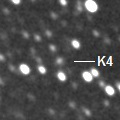
|
Now it is 15.3 mag (Sept. 18, Yuji Ohshima). It stays 16 mag for a long time until summer in 2018. In the Southern Hemisphere, it stays observable in excellent condition until autumn. It locates low in the Northern Hemisphere.
Date(TT) R.A. (2000) Decl. Delta r Elong. m1 Best Time(A, h)
Oct. 14 17 54.42 -26 23.4 2.997 2.785 68 15.8 18:50 ( 35, 19)
Oct. 21 18 5.64 -25 47.8 3.056 2.764 63 15.8 18:42 ( 37, 19)
|

|
Appearing in the morning sky. It will be observable at 15 mag in good condition from winter to spring.
Date(TT) R.A. (2000) Decl. Delta r Elong. m1 Best Time(A, h)
Oct. 14 10 48.29 13 18.0 4.227 3.556 42 16.1 4:41 (271, 24)
Oct. 21 10 56.38 12 37.3 4.153 3.553 47 16.1 4:46 (275, 29)
|

|
Appearing in the morning sky. It stays 16-17 mag for a long time from 2016 to 2019. It stays near by the equator.
Date(TT) R.A. (2000) Decl. Delta r Elong. m1 Best Time(A, h)
Oct. 14 10 17.77 4 38.5 10.221 9.558 46 16.2 4:41 (283, 26)
Oct. 21 10 20.56 4 28.6 10.134 9.559 52 16.1 4:46 (289, 31)
|
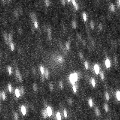
|
It brightened up to 13.5 mag in July (July 5, Chris Wyatt). But it is fading after that, even before the perihelion passage. It has already faded down to 15.9 mag (Sept. 11, Alexander Baransky). It is observable in excellent condition in the Southern Hemisphere. It locates somewhat low in the Northern Hemisphere.
Date(TT) R.A. (2000) Decl. Delta r Elong. m1 Best Time(A, h)
Oct. 14 19 44.73 -18 15.4 1.650 1.989 94 16.2 18:50 ( 11, 36)
Oct. 21 19 56.36 -17 15.9 1.725 1.994 90 16.4 18:42 ( 13, 37)
|
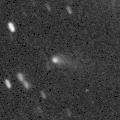
|
Now it is 16.1 mag (Sept. 27, Mt. Lemmon Survey). Return of a new periodic comet which brightened up to 13 mag in 2004. It will be observable in excellent condition in autumn. It was expected to brighten up to 14 mag, if the comet is as bright as when it was discovered. But actually, it is much fainter than expected.
Date(TT) R.A. (2000) Decl. Delta r Elong. m1 Best Time(A, h)
Oct. 14 2 43.25 5 29.9 0.749 1.716 158 16.4 1:14 ( 0, 61)
Oct. 21 2 39.24 6 38.8 0.736 1.718 165 16.4 0:43 ( 0, 62)
|
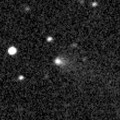
|
First return of a new periodic comet discovered in 2000. Now it is 15.9 mag (Sept. 26, Toshiyuki Takahashi). Although it has been brightening even after the perihelion passage, it will be fading after this.
Date(TT) R.A. (2000) Decl. Delta r Elong. m1 Best Time(A, h)
Oct. 14 0 42.01 -5 42.5 1.740 2.712 163 16.4 23:09 ( 0, 49)
Oct. 21 0 36.68 -4 59.4 1.787 2.733 157 16.5 22:36 ( 0, 50)
|
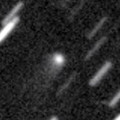
|
It stays 16 mag for a long time from 2017 to 2018. It is observable in excellent condition in the Northern Hemisphere. It locates very low in the Southern Hemisphere.
Date(TT) R.A. (2000) Decl. Delta r Elong. m1 Best Time(A, h)
Oct. 14 9 15.76 20 44.5 5.670 5.336 65 16.5 4:41 (277, 47)
Oct. 21 9 16.95 21 26.4 5.547 5.334 72 16.5 4:46 (282, 54)
|

|
Now it is 16.5 mag (Sept. 26, ATLAS-MLO, Mauna Loa). It stays 16 mag from 2016 to 2017. In the Northern Hemisphere, it stays observable in good condition for a long time. In the Southern Hemisphere, it will never be observable again.
Date(TT) R.A. (2000) Decl. Delta r Elong. m1 Best Time(A, h)
Oct. 14 18 3.85 61 7.3 6.539 6.589 88 16.7 18:50 (151, 56)
Oct. 21 18 9.83 60 38.7 6.558 6.605 88 16.7 18:42 (148, 55)
|
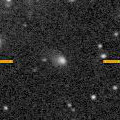
|
Now it is 16.7 mag (Sept. 25, Toshiyuki Takahashi). It is expected to brighten up to 13-14 mag from 2018 to 2019. In the Northern Hemisphere, it stays observable in good condition for a long time. In the Southern Hemisphere, it is not observable until summer in 2018.
Date(TT) R.A. (2000) Decl. Delta r Elong. m1 Best Time(A, h)
Oct. 14 18 25.86 55 9.4 5.205 5.291 89 16.8 18:50 (144, 62)
Oct. 21 18 25.99 53 21.3 5.194 5.246 87 16.8 18:42 (138, 60)
|
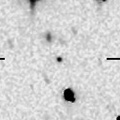
|
Now it is 17.0 mag (Sept. 26, Alexander Baransky). It will be observable at 16.5 mag in good condition in winter.
Date(TT) R.A. (2000) Decl. Delta r Elong. m1 Best Time(A, h)
Oct. 14 9 4.47 7 20.9 2.950 2.678 64 16.8 4:41 (294, 41)
Oct. 21 9 13.56 5 38.7 2.883 2.689 68 16.8 4:46 (302, 45)
|
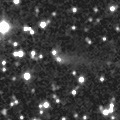
|
Now it is 16.5 mag (Sept. 28, Alexander Baransky). In the Northern Hemisphere, it will be observable at 17 mag in excellent condition from autumn to winter. It locates low in the Southern Hemisphere.
Date(TT) R.A. (2000) Decl. Delta r Elong. m1 Best Time(A, h)
Oct. 14 5 42.61 33 5.4 2.545 3.087 113 17.0 4:13 ( 0, 88)
Oct. 21 5 44.45 33 35.5 2.477 3.101 120 16.9 3:47 ( 0, 89)
|
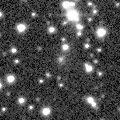
|
Now it is 16.7 mag (Sept. 15, Yuji Ohshima). It will pass the perihelion in 2019. However, it has not been brightening since the discovery in 2010. It is observable in good conditioin in the Northern Hemisphere. It is not observable for a long time in the Southern Hemisphere.
Date(TT) R.A. (2000) Decl. Delta r Elong. m1 Best Time(A, h)
Oct. 14 7 0.10 70 28.1 8.736 8.945 98 17.0 4:41 (187, 54)
Oct. 21 7 2.56 71 11.2 8.651 8.932 103 16.9 4:46 (183, 54)
|

|
Now it is 17.9 mag (June 2, MASTER-OAFA Observatory). It will brighten up to 14 mag from autumn to winter in 2018, and it will be observable in excellent condition in the Northern Hemisphere. In 2017, it is observable at 17 mag in excellent condition in the Southern Hemisphere.
Date(TT) R.A. (2000) Decl. Delta r Elong. m1 Best Time(A, h)
Oct. 14 23 14.31 -44 30.2 3.224 3.831 120 17.0 21:41 ( 0, 11)
Oct. 21 23 8.35 -43 32.1 3.250 3.788 115 17.0 21:08 ( 0, 12)
|
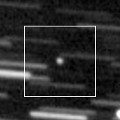
|
It will approach to Earth down to 0.07 a.u. in mid December, and it will brighten up to 10 mag. In the Northern Hemisphere, it stays observable in excellent condition until mid December. In the Southern Hemisphere, it stays low.
Date(TT) R.A. (2000) Decl. Delta r Elong. m1 Best Time(A, h)
Oct. 14 6 45.12 33 44.7 1.296 1.778 100 17.5 4:41 (278, 83)
Oct. 21 6 52.13 33 58.5 1.146 1.716 106 17.2 4:46 (300, 88)
|
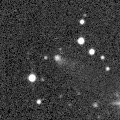
|
Now it is 17.3 mag (Sept. 24, E. Bryssinck). It is observable in good condition in the Northern Hemisphere. It locates very low in the Southern Hemisphere.
Date(TT) R.A. (2000) Decl. Delta r Elong. m1 Best Time(A, h)
Oct. 14 7 16.47 33 49.0 2.774 3.019 94 17.2 4:41 (270, 76)
Oct. 21 7 21.36 34 5.0 2.703 3.042 100 17.2 4:46 (274, 82)
|
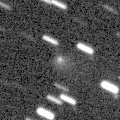
|
Hilda-type minor planet, but the cometary activity was detected on July 3. It brightened up to 16.5 mag. Now it is fading rapidly. It has already faded down to 18.1 mag (Sept. 18, Kunihiro Shima).
Date(TT) R.A. (2000) Decl. Delta r Elong. m1 Best Time(A, h)
Oct. 14 20 53.42 -4 24.0 3.009 3.525 113 17.4 19:21 ( 0, 51)
Oct. 21 20 55.99 -4 52.2 3.119 3.542 107 17.5 18:56 ( 0, 50)
|

|
Now it is 17.7 mag (Sept. 30, Catalina Sky Survey). It stays observable at 16 mag for a long time until summer in 2018. It is observable in good condition in the Northern Hemisphere in 2017, and in the Southern Hemisphere in 2018.
Date(TT) R.A. (2000) Decl. Delta r Elong. m1 Best Time(A, h)
Oct. 14 6 46.60 52 12.3 1.970 2.370 100 17.7 4:41 (198, 72)
Oct. 21 6 30.22 55 31.9 1.782 2.305 108 17.4 4:34 (180, 70)
|
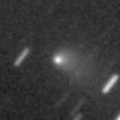
|
It brightened up to 14.7 mag in summer (Aug. 12, Yasukazu Ikari). Now it is fading rapidly. It has already faded down to 17.0 mag (Sept. 28, Yasukazu Ikari).
Date(TT) R.A. (2000) Decl. Delta r Elong. m1 Best Time(A, h)
Oct. 14 21 8.86 -12 45.6 2.095 2.676 115 17.7 19:37 ( 0, 42)
Oct. 21 21 12.08 -11 15.2 2.206 2.705 109 17.8 19:13 ( 0, 44)
|
|
![]()
 (3200) Phaethon
(3200) Phaethon 188P/LINEAR-Mueller
188P/LINEAR-Mueller 362P/(457175) 2008 GO98
362P/(457175) 2008 GO98 C/2017 S6 ( Catalina )
C/2017 S6 ( Catalina ) C/2017 D2 ( Barros )
C/2017 D2 ( Barros )![]()





































